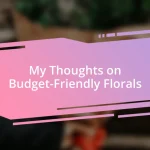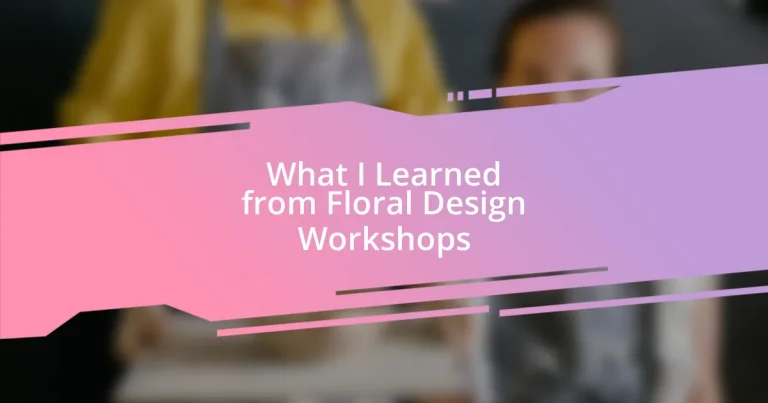Key takeaways:
- Understanding the principles of balance, proportion, and harmony is crucial in creating effective floral designs, allowing each arrangement to tell a visual story.
- Key techniques such as the spiral method, layering, and the use of negative space enhance the visual appeal and emotional impact of floral compositions.
- Incorporating seasonal and local flowers adds authenticity and depth to arrangements, making them resonate with the essence of their time and place.

Understanding Floral Design Basics
In floral design, understanding the principles of balance, proportion, and harmony is essential. I remember my first workshop vividly—standing in front of a disarray of flowers, unsure of how to create something beautiful. It struck me then how every arrangement is like telling a visual story, conveying emotions through color and structure.
The use of color in floral design can evoke specific feelings and atmospheres. During one of my workshops, we explored color theory, and I realized how different shades could change the entire mood of an arrangement. Isn’t it fascinating how a vibrant red can ignite passion, while soft pastels can evoke tranquility? It’s incredible how floral design intertwines with our emotions.
Proportion is another critical basic that I found important in floral arrangements. Recall those times when you’ve seen an overwhelming bouquet that seemed to overshadow everything? When I learned to blend large, medium, and small elements thoughtfully, my designs became more cohesive. I often wonder, how can a single arrangement carry so much weight and significance? It’s a dance of proportions that brings the entire piece to life.

Key Techniques in Floral Arranging
When diving into floral arranging, I discovered that one of the key techniques is the ‘spiral method.’ This approach creates a natural, flowing arrangement that feels effortless. I remember one workshop where we practiced this method, twisting stems in our hands like we were creating a melody. It was thrilling to see how the flowers danced together, creating a harmonious look without any fuss.
- Spiral Method: A technique that involves twisting stems in a circular fashion to create a dynamic, organic structure.
- Grid Technique: Using a grid structure can help maintain stability and provide a clear guide for placement.
- Contact Points: In every arrangement, I learned the importance of establishing contact points—those little moments where flowers touch, grounding the design.
- Layering: Incorporating layers of blooms by varying heights creates depth and visual interest, leading the viewer’s eye through the arrangement.
Another technique that stood out to me was ‘negative space’, which is the art of leaving certain areas open. The first time I tried this, I felt a mix of apprehension and freedom. It was bizarre to think that emptiness could enhance my design. But as I stepped back, I saw how the space allowed the flowers to breathe and shine, transforming the arrangement into something more profound and inviting.

Tools and Materials for Success
Tools are the backbone of any floral designer’s creativity, and over time, I’ve learned that having the right ones can make a significant difference. I still remember the first time I tried using floral foam. I was a bit skeptical at first, but once I saw how it helped my designs hold shape and water, I was sold! It felt like having a personal assistant that allowed me to focus on my artistic vision without worrying about how the flowers would stand.
In addition to tools, the materials you choose play a crucial role in shaping your overall designs. I vividly recall a workshop where variety was emphasized. Suddenly, I had a bouquet of unusual stems, textures, and colors in front of me. I never expected how much joy came from experimenting with things like dried flowers or unique foliage! Each one told a different story, and it was exhilarating to mix them in unexpected ways. Have you ever felt like a child in a candy store? That’s exactly how I felt—like endless creativity was just waiting to be explored.
Understanding the differences between various tools and materials not only lays the foundation for successful floral arrangements but also uncovers your unique style. For me, learning which shears worked best on different types of stems was a revelation! It became clear that precision is key, just like when you select the right colors for your artwork. As I began to use tools effectively, I noticed that each cut and placement became a closer reflection of my personality, opening up a world full of potential.
| Tool/Material | Description |
|---|---|
| Floral Foam | A foam block that provides structure and holds water for flower stems. |
| Tape (Floral/Grip Tape) | Used for securing arrangements or creating grids for support. |
| Flower Shears | High-quality cutters that make precise cuts for better hydration. |
| Vases | Variety of shapes and sizes that influence arrangement style. |
| Dried Flowers | Long-lasting materials that add texture and depth to designs. |

Creative Composition in Floral Design
Creative composition in floral design requires more than just technique; it thrives on the excitement of experimentation. I once found myself in a workshop, feeling a sense of unease about choosing colors. As I gathered my blooms, I noticed how bold contrasts combined with lighter shades, creating a delightful tension. There’s a certain thrill that comes from taking chances—have you ever felt the rush of stepping outside your comfort zone? That day, I discovered that breaking the rules often leads to the most captivating arrangements.
Layering different types of flowers displayed their unique shapes, adding an alluring depth to my designs. I distinctly recall my first attempt at creating a multi-layered arrangement; it was like putting together a jigsaw puzzle where every piece has a story. As I played with varying heights, I felt each flower interact with its neighbors, guiding the viewer’s gaze and creating a flow. It was a beautiful reminder that each element in the design has a role to play, just like in a well-composed symphony.
The concept of negative space often felt intimidating, but it quickly became one of my secrets. During a vibrant workshop, I deliberately left an area bare, unsure if I was making a mistake. But stepping back to admire my work, I realized that the gap breathed life into my composition. Isn’t it fascinating how sometimes, less truly is more? Embracing negative space taught me that allowing breathing room creates a dialogue between flowers, enhancing their beauty while inviting the viewer to reflect.

Incorporating Color Theory Effectively
Incorporating color theory into floral design is not just about picking pretty shades; it’s a dance between hues that can evoke emotions and set the mood. I vividly remember a workshop where we tackled the color wheel—what an eye-opener! Creating a bouquet that played with analogous colors, those next to each other on the wheel, made me appreciate how they harmoniously blended. Did you ever wonder why some combinations just resonate? That’s the magic of understanding how colors work together!
When I experimented with complementary colors—those that sit opposite each other, like purple and yellow—I was amazed by the vibrancy it brought to my arrangements. It felt like adding a spark to a conversation! I’ll never forget the time I used dark purple dahlias next to bright yellow roses; the contrast was striking. It made me realize that just like in life, the most unexpected pairings can create stunning results. Have you ever paired colors and thought, “Wow, this completely changes the vibe?”
One practical insight I’ve gleaned is to not shy away from experimenting with shades and tones. My first attempt at creating an ombre effect with varying shades of the same color left a lasting impression on me. It not only added depth but also a sense of movement to the arrangement. I still recall the way the subtle transition of pinks from light to dark drew everyone’s attention. Have you ever noticed how certain color gradients can tell a story? That’s what I strive for in every creation! Embracing these color strategies makes the floral design process not just an art form, but an emotional journey that’s uniquely personal.

Tips for Seasonal Floral Designs
Seasonal floral designs are all about embracing what nature offers at different times of the year. I recall a crisp fall day at a workshop where we used vibrant autumn leaves and rustic elements like pinecones. It felt invigorating to create arrangements that reflected the changing season, providing a visual story that resonated with everyone. Have you ever noticed how certain flowers seem to embody the essence of a season? That’s the beauty of aligning your work with nature’s rhythm.
One tip that has truly transformed my approach is to incorporate local, seasonal blooms. During a summer workshop, I found myself using sunflowers and zinnias right from a nearby farm. The freshness and vibrancy of those locally sourced flowers added a layer of authenticity that store-bought blooms simply couldn’t match. It’s astonishing how tapping into what’s in season can elevate your designs. Have you ever thought about the impact of choosing flowers that are in their prime?
When designing for special occasions, I learned to consider seasonal themes and events. I participated in a winter workshop where we crafted arrangements using evergreen branches and holiday-themed flowers like poinsettias. The magical scent of pine was a constant reminder of the festive atmosphere, allowing me to capture the spirit of the season. It reinforced the idea that floral designs can evoke memories and emotions tied to specific times of the year. Isn’t it incredible how a simple arrangement can transport you back to a cherished moment?

Insights from Experienced Designers
Experiencing workshops alongside seasoned floral designers provided me with a treasure trove of insights. One designer emphasized the importance of balance in arrangements—something I hadn’t really considered before. After experimenting with varying heights and textures, I discovered that a well-balanced design draws the eye in and creates visual interest. Have you ever stared at a piece and felt something was off? It’s often that missing element of balance that makes all the difference.
Another captivating lesson came from a designer who illustrated the impact of texture in floral compositions. During a session, she encouraged us to mix soft petals with rugged foliage, and I couldn’t believe how much that added to the dynamics of the arrangement. I still remember the rich combination of velvety roses against the coarse leaves of ornamental grasses—it was like a beautiful conversation between contrasts! Doesn’t it make you ponder how the tactile sensation of flowers can evoke deeper emotional responses?
Listening to the stories shared by these experienced designers also opened my eyes to the significance of storytelling in floral arrangements. There was a moment when one designer shared the inspiration behind a wedding bouquet she created, explaining how each flower symbolized a facet of the couple’s journey. It struck me that each arrangement could tell a unique narrative, reflecting the emotions and moments tied to it. Have you ever thought about the stories your own designs could narrate? This realization has transformed how I approach every piece I create, infusing each arrangement with meaning and intention.












